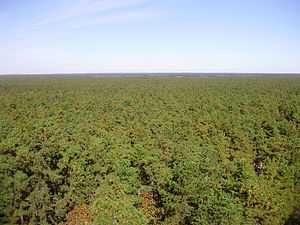Pinus rigida
| Pinus rigida | |
|---|---|
 | |
| Conservation status | |
| Scientific classification | |
| Kingdom: | Plantae |
| Division: | Pinophyta |
| Class: | Pinopsida |
| Order: | Pinales |
| Family: | Pinaceae |
| Genus: | Pinus |
| Subgenus: | Pinus |
| Species: | P. rigida |
| Binomial name | |
| Pinus rigida Mill. | |
 | |
Pinus rigida, the pitch pine, is a small-to-medium-sized (6–30 m (20–98 ft)) pine, native to eastern North America. This species occasionally hybridizes with other pine species such as loblolly pine (Pinus taeda), shortleaf pine (Pinus echinata), and pond pine (Pinus serotina); the last is treated as a subspecies of pitch pine by some botanists.
Distribution
Pitch pine is found mainly in the southern areas of the northeastern United States, from coastal Maine and Ohio to Kentucky and northern Georgia. A few stands occur in southern Quebec and Ontario. This pine occupies a variety of habitats from dry acidic sandy uplands to swampy lowlands, and can survive in very poor conditions; it is the primary tree of the New Jersey Pine Barrens.[2]
Description
The needles are in fascicles of three, about 6–13 cm (2.4–5.1 in) in length, and are stout (over 1 mm (0.039 in) broad) and often slightly twisted. The cones are 4–7 cm (1.6–2.8 in) long and oval with prickles on the scales. Unusual for pines, if the main trunk is cut or damaged by fire it can re-sprout using epicormic shoots. This is one of its many adaptations to fire, which also includes a thick bark to protect the sensitive cambium layer from heat. Burnt trees often form stunted, twisted trees with multiple trunks as a result of the resprouting. This characteristic also makes it a popular species for bonsai.
Uses
Pitch pine is not a major timber tree, due to the frequency of multiple or crooked trunks; nor is it as fast-growing as other eastern American pines. However, it grows well on unfavourable sites. In the past, it was a major source of pitch and timber for ship building, mine timbers, and railroad ties because the wood's high resin content preserves it from decay. Pitch pine wood was also used for building radio towers in Germany as at Muehlacker and at Ismaning.
Pitch pine is currently used mainly for rough construction, pulp, crating, and fuel. However, due to its uneven growth, quantities of high quality can be very sought after, and large lengths of pitch pine can be very costly.
Gallery
-

New growth and pollen cones
-

Cone and needles
-

View north from a fire tower on Apple Pie Hill in the New Jersey Pine Barrens. The vast pine forest is almost entirely made up of Pinus rigida.
References
- ↑ Farjon, A. (2013). "Pinus rigida". IUCN Red List of Threatened Species. Version 2013.1. International Union for Conservation of Nature. Retrieved 17 July 2013.
- ↑ Moore, Gerry; Kershner, Bruce et al. (2008). National Wildlife Federation Field Guide to Trees of North America. New York: Sterling. p. 756. ISBN 1-4027-3875-7.
External links
| Wikimedia Commons has media related to Pinus rigida. |
